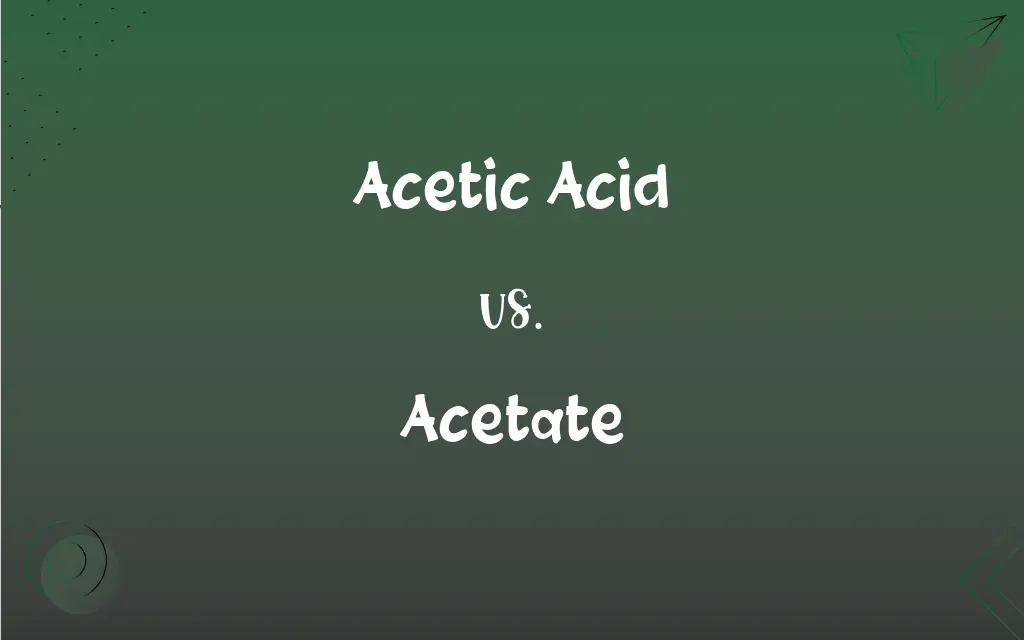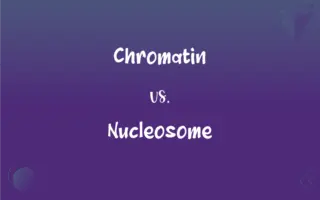Acetic Acid vs. Acetate: What's the Difference?
Edited by Harlon Moss || By Janet White || Published on December 16, 2023
Acetic acid is a weak organic acid, while acetate refers to its anion or salt derivatives.

Key Differences
Acetic acid is an organic compound with the formula CH3COOH, known for its sour taste and pungent smell, commonly found in vinegar. Acetate, on the other hand, is the negatively charged ion (CH3COO−) or any salt and ester containing this ion, derived from acetic acid.
In chemical structure, acetic acid consists of a methyl group linked to a carboxyl group, making it a carboxylic acid. Acetate is formed when acetic acid loses a hydrogen atom from its carboxyl group, leading to the formation of a negatively charged ion.
Acetic acid acts as a weak acid in aqueous solutions, partially dissociating into hydrogen ions and acetate ions. Conversely, acetate usually exists in a more stable ionic form, readily combining with cations to form various salts.
In biological systems, acetic acid plays a crucial role in metabolism, notably in the vinegar fermentation process. Acetate, being a derivative, is involved in numerous biochemical pathways, often as a key intermediate.
Industrially, acetic acid is used in the manufacture of a variety of compounds, including plastics and textiles. Acetate forms are widely used in applications like solvents, photography, and food additives.
ADVERTISEMENT
Comparison Chart
Chemical Formula
CH3COOH
CH3COO−
Physical State
Liquid at room temperature
Usually found as a part of a salt or ester
Role in Solutions
Acts as a weak acid
Exists as an anion
Biological Function
Involved in metabolic processes
Intermediate in biochemical pathways
Industrial Applications
Used in manufacturing plastics, textiles
Used in solvents, photography, food
ADVERTISEMENT
Acetic Acid and Acetate Definitions
Acetic Acid
A chemical reagent for the production of chemical compounds.
Acetic acid is used in the synthesis of acetate esters.
Acetate
A compound used in making synthetic fibers and plastics.
Cellulose acetate is used in producing photographic film.
Acetic Acid
A key ingredient in vinegar used for culinary purposes.
Acetic acid gives salad dressings their tangy flavor.
Acetate
A solvent in the dyeing and printing industry.
Acetate solvents are essential in textile printing.
Acetic Acid
A weak carboxylic acid used in food preservatives.
Acetic acid is added to pickles to enhance their shelf life.
Acetate
A component in many food additives and medicines.
Calcium acetate is used as a food preservative.
Acetic Acid
A sour-tasting compound that acts as an antimicrobial agent.
Acetic acid's antimicrobial properties make it a useful disinfectant.
Acetate
A negatively charged ion derived from acetic acid.
Acetate ions are produced when vinegar is diluted in water.
Acetic Acid
A colorless liquid organic compound with a pungent odor.
Acetic acid is the main component of vinegar.
Acetate
A salt or ester of acetic acid.
Acetate
Cellulose acetate or any of various products, especially fibers, derived from it.
Acetate
(organic chemistry) Any salt or ester of acetic acid.
Acetate
Cellulose acetate.
Acetate
A transparent sheet used for overlays.
Acetate
Ellipsis of acetate disc: a disc of aluminium covered in a wax used to make demonstration copies of a phonograph record.
Acetate
A salt formed by the union of acetic acid with a base or positive radical; as, acetate of lead, acetate of potash.
Acetate
A salt or ester of acetic acid
Acetate
A fabric made from cellulose acetate fibers
FAQs
What is acetic acid commonly found in?
Vinegar.
Can acetic acid be used as a disinfectant?
Yes, due to its antimicrobial properties.
What is a common use of acetate in food?
As a preservative.
Is acetate always found in a solid form?
No, it's often part of a salt or ester.
What forms does acetate come in?
Salts, esters, and the ion itself.
What is the role of acetate in photography?
It's used in making photographic film.
Is acetic acid volatile?
Yes, it has a pungent smell and evaporates at room temperature.
Can acetate form salts?
Yes, with various cations.
Are there industrial uses for acetic acid?
Yes, in manufacturing various compounds.
Is acetic acid a strong acid?
No, it's a weak acid.
Is acetate toxic?
Generally, it is safe, but depends on the specific compound and concentration.
Is acetic acid used in food?
Yes, particularly in vinegar and preservatives.
Can acetic acid be used in cleaning?
Yes, due to its acidity and antimicrobial properties.
Are there medical uses for acetate?
Yes, in various medications and treatments.
Can acetic acid affect the pH of a solution?
Yes, it can lower the pH when added to a solution.
What is a unique property of acetate in textiles?
It's used as a solvent in dyeing processes.
Can acetate be found in biological systems?
Yes, as a biochemical intermediate.
How is acetic acid produced industrially?
Through the fermentation process or chemical synthesis.
Is acetic acid flammable?
It can be flammable under certain conditions.
Can acetate be used in printing?
Yes, particularly in textile and screen printing.
About Author
Written by
Janet WhiteJanet White has been an esteemed writer and blogger for Difference Wiki. Holding a Master's degree in Science and Medical Journalism from the prestigious Boston University, she has consistently demonstrated her expertise and passion for her field. When she's not immersed in her work, Janet relishes her time exercising, delving into a good book, and cherishing moments with friends and family.
Edited by
Harlon MossHarlon is a seasoned quality moderator and accomplished content writer for Difference Wiki. An alumnus of the prestigious University of California, he earned his degree in Computer Science. Leveraging his academic background, Harlon brings a meticulous and informed perspective to his work, ensuring content accuracy and excellence.






































































